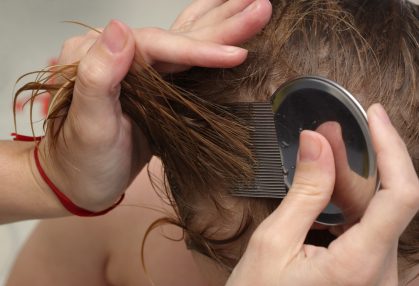Natural home remedies: Head lice
Head lice aren’t fun’which is why it’s so important to deal with them fast. Try these tips on banning lice from your home, plus some home remedies to try

Source: Adapted from 1,801 Home Remedies, Reader’s Digest
Something is definitely moving in your hair, and the itching is driving you buggy. And that’s precisely the problem: Your tresses are now a cozy domicile for the common head louse, otherwise known as Pediculus humanus capitis. Just 1.6 millimeters long, these wingless insects live close to the scalp, laying their eggs (nits) and feeding on your blood. When lice appear in school-age children, word usually gets around quickly, and parents are warned to be on the lookout. Lice spread via contact with contaminated hair, hairbrushes, combs, clothing, or bedding.
What to do about head lice
Once lice are in the hair, even a burr cut won’t help. You need to get rid of the louse eggs that are attached to the hair shafts about five millimeters from the scalp. Start by using a delousing shampoo. Choose one that contains permethrin, not lindane. Lindane is a chemical cousin of the pesticide DDT and has been linked to nervous system problems (including convulsions) and brain cancer. Once you’ve found a killer shampoo, the remaining challenge is to use it effectively and become very nitpicky about preventing contamination. Otherwise, your whole household could get lousy.
Start with shampoo
‘ Use a delousing shampoo, and leave it in your hair for 10 minutes. That’s a long time to spend in the shower, so you may prefer to do your shampooing in the bathtub, where you can read or listen to music while the shampoo does its job.
‘ After you rinse out the shampoo, rinse it again using 50% water and 50% white kitchen vinegar. The vinegar helps dissolve the bodies of dead nits. Rub it in vigorously, then rinse your hair a few times to dispel the odour.
‘ Use the louse-killing shampoo again 10 days later. If you’re still not getting results, mix a half-cup vinegar with a half-cup olive oil. About an hour before you take your bath or shower, apply this mixture to your hair, working it in close to the scalp. Put a shower cap over your hair. After an hour, remove the cap and take your shower, washing your hair with regular shampoo.
The natural approach
‘ If you’re wary of synthetic pesticides, you may be able to smother lice while you sleep. First, saturate the hair and scalp with mayonnaise, then put on a shower cap. The next morning, lice should be dead. Unfortunately, you can’t smother the louse eggs’you’ll still have to remove them by hand.
‘ Petroleum jelly can have a stifling influence on roaming lice. Apply a thick layer of petroleum jelly to the scalp, then cover with a shower cap. Leave it on overnight. In the morning, use baby oil or mineral oil to remove the petroleum jelly’and the lice along with it. Repeat several nights in a row. (One warning, though: it may take a lot of shampooing before you get all the petroleum jelly out of your hair!)
‘ Essential oils can kill lice and help soothe the itching. There are many different ‘recipes.’ One effective combination is 20 drops tea-tree oil, 10 drops rosemary oil, and 15 drops each of lemon (or thyme) and lavender oil mixed into 4 tablespoons vegetable oil. Rub the mixture into your dry hair, cover your head with a plastic shower cap, then wrap that with a towel. After an hour, unwrap your head, shampoo well, and rinse.
Be picky
‘ No matter what you do to get rid of lice, careful inspection is also essential. If you have lice, ask your partner to go through your hair slowly with a metal lice comb (available at drugstores) and look for nits or lice. If your child’s head is infested, you may have to use TV to get the child to sit still through this process. Nits are yellowish-white, oval-shaped, and adhere to the hair shaft at an angle. They look a bit like dandruff, but they don’t drift out of your hair the way dandruff does. Mature lice grow to about the size of sesame seeds. Freshly hatched lice are clear; those approaching midlife (about a week old) are reddish-brown. If you see lice, remove them with an emery board or Popsicle stick. If you use your fingers, still-living nits might get under your nails.
Stop the spread
‘ When someone in the family has lice, keep all combs and brushes separate. And make sure no one comes into contact with hats, scarves, hair ribbons, etc., that have been worn by the affected person.
‘ After treating the lice, wash clothing, bedding and other washables that have been used by the affected person in hot, sudsy water. Seal nonwashable items in plastic bags for a week (or three days in the refrigerator).
‘ After a coat has been worn by someone who has lice, put it in the dryer to make certain all lice and eggs are killed.
When to see your doctor
These remedies will usually take care of a run-of-the-mill case of head lice. But you’ll need a doctor’s help if self-treatment fails, or if the skin on the scalp becomes cracked or inflamed.
Don’t miss out! Sign up for our free weekly newsletters and get nutritious recipes, healthy weight-loss tips, easy ways to stay in shape and all the health news you need, delivered straight to your inbox.




